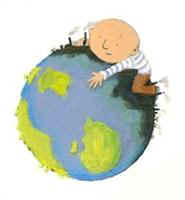
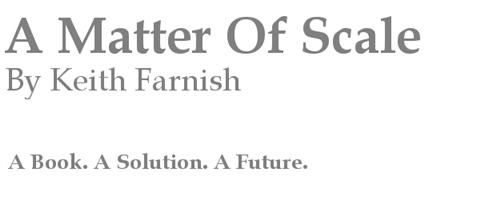
  |
Chapter
8
What
Are We?
If you live in the ridiculously named
“Developed World”, then you are probably not happy. Even if you think you
are happy and feel contented with your lot, you are probably still not happy,
and if you really are then it probably won’t last. If you live in the equally
ridiculously named “Developing World” then you may well be very happy indeed
and not even realise it.
There is a good reason for this,
and it will become clear shortly. But I’m not going to tell you why in this
chapter, because first I need to explain a bit about what we are made of.
Knowing this is key to understanding our place in the world.
*
* *
Life as
we know it would not exist without deoxyribonucleic acid, or DNA. These
long-strand molecules are essentially copying machines: they create duplicates
of themselves throughout every cell of an organism. When the organism dies, if
it hasn’t reproduced, then the DNA will be stopped in its tracks – it will
have failed.
DNA doesn’t “want” to survive – you cannot ascribe
human characteristics to a chain of complex molecules – it just happens to
have that function. Organisms are simply carriers for DNA, or Survival Machines[i].
Organisms may not understand why they need to reproduce (although we have no way
of knowing for sure) but they all “feel” that they must reproduce, and in
order to reproduce they must be able to survive. Humans realise, at a high
level, that they want to reproduce, but how many realise that this desire to
reproduce (and also to survive) is simply the calling of their DNA molecules?
Some of you may be thinking that
I’ve left an element out of here; where is the Creator? This book assumes that
evolution is a fact, but in the interests of harmony I have no wish at all to
give you a lecture on the rights and wrongs of evolution or religion – at
least not yet. If you want a good read, then I recommend both The Selfish Gene
and The Ancestor’s Tale by Richard Dawkins from your library. There, I have
put my heart on my sleeve, but please give me time to explain myself.
Whatever you believe, knowing
what humans think they are is very important. To start with, I’m going to run
a few opinions past you that other people have given me[ii].
Human Beings are…
…God’s creation
…a fluke of the universe
…mostly harmless
…the most dangerous animals on the
planet
…fallible
…finite
…an infestation upon the Earth
…bipedal carbon-based life forms
…here for a fleeting moment
…the pinnacle of evolution
…the pinnacle of creation
…stupid
…unaware of how lucky they are
…they just are
Without some serious mental
rewiring, it is not possible for one person to simultaneously and sincerely
believe all of these opinions. Some of them you may sincerely believe, and some
of them you won’t. With half an eye on the list above, I’m going to break
the explanation of what we are into four small sections, each of which concerns
a different physical aspect of humanity. First of all, we need to know where
humans stand, sit, kneel or lie down compared to other forms of life.
Our
Place In The Tree Of Life
Taxonomy
is a branch of science concerned with putting things into a certain order, and
taxonomy is used to create something called the Phylogenetic Tree, of which
humans form a part. Within this monstrously complicated network of trunks,
branches, twigs and leaflets, can be found humans; as we see in Figure 1.
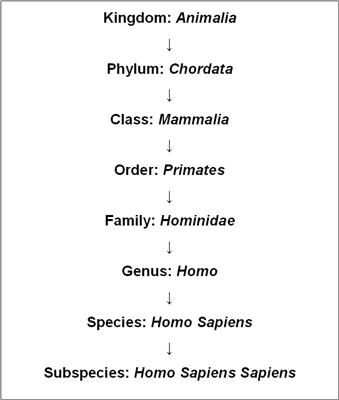
Figure
1
: Human Phylogenetic
Tree (Source: Author’s image)
Reading from the top downwards,
you can see that it takes eight stages to get to modern humans. Not all species
or sub-species take so many levels to get to; humans are a pretty special case,
being rather central to our way of seeing things. In fact, humans would be
recognisable at the level of the Family Hominidae, even though all living
humans are undoubtedly of the same Species.
As you move back through history,
you discover that our connections to the rest of the animal kingdom are not
really that obscure. Richard Dawkins refers to common links between different
branches on the phylogenetic tree as Concestors[iii].
We share a concestor with, first, bonobos and chimpanzees, then gorillas,
orang-utans and gibbons. Our common link with our closest surviving animal
relation, the chimpanzee, with which we share at least 95 percent of our DNA,
probably existed 6 million years ago – a blink in the eye of geological time.
Ten concestors back and we connect to the rodents. Fifteen concestors, and we
are at one with the duck-billed platypus. Humans and amphibians share a common
ancestor at 340 million years BP (before present), and it was 460 million years
ago – still only a tenth of the Earth’s lifetime - that we split off from
the same branch that we share with sharks.
The Animal Kingdom first emerged,
as the jellyfish like Ediacara, anything up to 2000 million years ago[iv]
but, as we have seen in Part One, animals were, and are, most certainly not
alone. Right up at the level of Kingdom, we find that Animalia is just
one of many.
Kingdoms of Life according to ITIS[v]
Animalia: The animals, of which
we are part. This kingdom is extremely diverse, but not the most diverse
kingdom. It includes all insects, fish, mammals, crustaceans, molluscs, corals
and worms, among other things.
Plantae: Plants. The most
physically diverse kingdom of all, and probably the largest in terms of total
mass. Includes all mosses, multicellular algae (in all its many hues), flowering
plants, trees and grasses. Without plants humans would have no food, except for
fungi.
Chromista: Possibly a kingdom of
its own, formed of algae which may or may not be included in the Plant Kingdom
(confusing, I know).
Fungi: A kingdom that seems
simple enough but includes a vast array of different sac fungi; club fungi –
including all mushrooms and toadstools; yeasts and moulds. Without fungi,
nothing would decay, and there would be no soil.
Monera: Bacteria. As we saw in
Part One, bacteria are everywhere and without them life on Earth would not have
been able to develop. This is now usually divided into the True Bacteria and the
more resilient Archaea.
Protozoa: These are the
single-celled animals. They feed on bacteria and molds, and they are food for
many larger creatures, as well as being an important source of disease.
Nothing is simple in the world of
taxonomy, though. Because True Bacteria and Archaea are considered to be so
different from all other forms of life, they are often classified as forming two
of the three Domains in which all life is included, leaving all other life forms
on their own branch. Outside of these domains are viruses, as discussed in Part
One; no one is really sure where they should go. If we bring together all
different life forms in a single vast genetic tree, we get something like Figure
2.
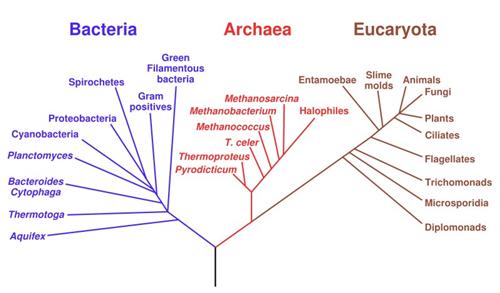
Figure 2: Domains Of Life
(Source: Wikipedia Commons)
All animals, including us, sit on
one sub-branch, in the right hand corner, next to slime moulds[vi].
Go back just 500 years, though, and the common viewpoint – scientific or
otherwise – was that Man was undoubtedly the dominant being on the Earth.
Aristotle, that Greek bastion of self-promotion, conceived the idea that all
life forms in existence were set upon a scale that reflected the “degrees of
perfection” that each was endowed with. This was extended right up to the
Middle Ages in Europe to include various religious entities at the pinnacle of
which was God, the Creator[vii].
Such an egocentric viewpoint, with humans just a few rungs below God, and
everything else less “perfect”, is not such an uncommon view even today.
Of course, humans are just one
very small (if relatively numerous) part of the Animal Kingdom. We find our
place among the thousands of different species of mammals, which sit alongside
the amphibians, reptiles and other animals that have backbones; but most species
of animal do not have backbones. Huge numbers of animals have shell-like
exoskeletons, protective shells, or no form of skeletal matter at all – we are
in the minority. Incredibly, there may be as many as 20 million different animal
species. Most of them may consist of only a few specimens, but others are
teeming with unimaginable numbers. Ants and termites, for instance, may form
between twenty and thirty percent of the total animal mass of some large
terrestrial ecosystems[viii].
In July 2007 there were 6.6 billion humans on Earth. There are very
approximately two hundred thousand trillion termites[ix].
This is not some deliberate ploy
to make you feel small and insignificant, or even mostly harmless; there is no
doubt, however, that our impact on Earth – as described in Part One – is out
of all proportion to our global biological significance.
How
Significant Are We?
After all
that you may be thinking, “If we’re so small and insignificant, how come we
are able to change life on Earth so much?” and you would be right to ask that
question. If we were to base the importance of an organism upon how much
potential an organism has for long-term survival, then you might think that Homo
Sapiens Sapiens would be at the top of the pile. You would be very wrong. If
you recall the way in which life forms are dependent upon each other, then one
thing becomes startlingly clear: most individual life forms that we are familiar
with cannot survive on their own. Insects feed off plants and other animals;
fish eat plankton, weed and other sea creatures; humans can live off nothing but
plant matter, but generally consume a combination of plants, animals and fungi.
But here’s the catch: all of
the organisms mentioned in the previous list are Heterotrophs; meaning they
cannot produce enough food of their own to survive without feeding off another
organism. Autotrophs, on the other hand, can make all of their food from raw
materials – sun, air, rocks, dissolved minerals, volcanic gases. The vast
majority of plants and algae, along with many bacteria are autotrophs, and it is they, the
organisms that can survive without any help, often in extreme conditions[x],
that first colonised this planet. Humans are often described as the “ultimate
predator” – the supreme killer which all other creatures submit to, albeit
unwillingly. In energy terms, humans occupy a number of trophic (food) levels,
and often make conscious decisions which level they which to occupy: from the
vegan who consumes nothing but direct plant matter, to the omnivore who may be
consuming something, that consumed something, that consumed something, that
consumed something else. This makes us extremely flexible, able to take
advantage of a vast range of food sources, which has contributed to the success
of the species. In effect we are not just the ultimate predator, but also the
ultimate scavenger – fussy eaters take note. Nevertheless, humans are, as we
saw throughout Part One, extremely vulnerable to changes in the ecosystems that
support them.
Imagine you are sitting on a
beach, facing the open ocean with nothing but miles of cream-coloured sand
stretching to either side of you. Hunger strikes, and there is nothing, nothing
at all, for you to eat. The sea is barren; marine life having been fished to
near-extinction. The sands are dry and devoid of green matter. Reptiles that
once basked in the warm sun before scuttling away to find insects have not
survived whatever armageddon led to this situation. The Earth is an apparently
lifeless globe of ocean and land: you will surely starve to death as the last of
your kind. If only you could use the energy of the sun to convert the air and
the minerals from the Earth into food. If only the tiny trace elements that sit
exposed on the grains of sand could be converted into some sort of sustenance.
You may have reached an evolutionary pinnacle of sorts, but you are incapable of
living without the efforts or the bodies of other organisms to feed you.
If we
aren’t careful, the autotrophs will inherit the Earth.
The
Problem Of Population
In
2012, the world human population is expected to break the 7 billion mark[xi],
and by around 2060 will probably reach around 10 billion. This phenomenal growth
rate suggests an organism that is out of control: like bacteria that teem and
multiply in an infinitely rich soup of nutrients, or a rampant tumour that must,
somehow, be excised.
Demographic
history tells us a very important lesson about the nature of humanity, and how
our opportunistic behaviour has made us so dominant. Figure 3 shows the
world population[xii]
over the last 12,000 years, beginning with the very approximate estimate of 1
million people in 10,000 BCE (Before Common Era)[xiii]
and not doing much for about 9,000 years. It is not until after 1500 CE (Common
Era)[xiv]
that things begin to get going, and if you look to the far right of the graph
then it is clear that the population is only really starting to go up as the
year 2000 approaches.

Figure
3: World Population in the last 12,000 years (Source: Author’s Graph)
In order to get a clearer view of
our population history, you need a far more recent set of data to go on, as
shown by Figure 4. Even with only 2000 years to represent the history of
human population growth, you have to examine the last tenth of the graph to see
something really notable happen.
In the 200 years up to the year
2005 the human population increased from just over 800 million to 6500 million.
Between 1900 and 2005 alone, the population grew from 1550 million to the giddy
heights of today’s vast humanitarian swarm. According to the Optimum
Population Trust[xv],
the Earth may be able to sustainably support 4.6 billion people. Their
analysis seems to be reasonable; in which case we have already overshot that
“carrying capacity” by about 50 percent, with the overshoot getting more
critical all the time.
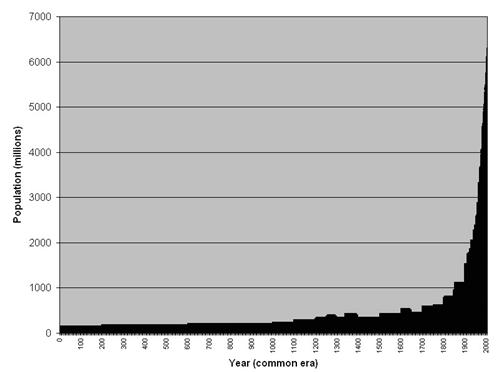
Figure
4: World Population in the last 2,000 years (Source: Author’s Graph)
What is evident from the graphs
is that for most of human history, the population really didn’t change much at
all. Up to the first great wave of animal domestication by humans, in about
10,000 BCE[xvi],
the population was stable at around 1 million. Domestication made it possible
for humans to stay in one place and eat, instead of foraging for food –
farming was born. Population growth remained fairly steady as the reach of
domestication spread for the next 9,000 years or so throughout the world, but it
wasn’t until the emergence of the first modern civilizations in the
Mediterranean basin and the Middle East that high-density human living and mass
transportation allowed the population to increase more easily, where previously
people had had to remain close to the source of their food. This would become
very significant later on.
Growth accelerated in the late 19th
century. Up to this point the largest regional populations had been in China,
India and South East Asia, which had economically benefited from agricultural
methods developed over thousands of years. The Industrial Revolution provided a
source of wealth, and further inducement to multiply, for the increasing
population of Europe[xvii],
which grew rapidly in the late 19th and early 20th
century; but more than anything else it was the ability of humans to exploit and
open up huge areas of land for food production which allowed the world
population to keep increasing. Despite wars, the constant threat of disease, and
natural disasters, humans found ways to survive, and thrive. According to the
United Nations: “The rapid growth of the world population started in 1950,
with reductions in mortality in the less developed regions, resulting in
a…population of 6.1 billion in the year 2000, nearly two and a half times the
population in 1950.”[xviii]
Why has the population grown at such a dramatic rate in the last 60 years? Superficially, the answer is that people are not dying as readily as they did up to the middle of the 20th century. Infant mortality rates in most parts of the world are at the lowest since detailed records were first taken, and human life expectancy – at least in rich nations – is similarly at its highest…for the time being. Good nutrition along with widespread conventional medicine (including vaccinations) and sanitation are ensuring humans live through situations that, only 50 years previously, would have been almost certainly fatal. I said that this was just the superficial answer because we have created a situation where, even as we create more virulent strains of disease and – through our consumer lifestyles – subject our bodies to ever-increasing strain, we are just about winning the battle against early death. For the moment. This has ensured that, if the Earth is able to sustain us (and that is a huge “if”), there will be 10 billion humans crawling, walking, driving and flying around the Earth in the not too distant future.
We may think of ourselves as
superlatively mobile and adaptable today, but it appears that between
100,000 and 10,000 BCE humans had travelled the world and occupied every
continent except for Antarctica[xix],
and this during a period of almost perpetual Ice Age. In that time, with a world
population of less than a million, such mobility would have had little impact on
the global ecosystem. As of about 1982, when we overshot the Earth’s carrying
capacity, our current way of living meant that the Earth was simply unable to
support the number of people living on its surface without something starting to
go very wrong.
Civilized
Humans
The auks
and the herring gulls have their cliffs; from the shallow sandstones to the
precipitous overhanging crags of limestone and granite, battered by thunderous
waves, but rich in plant and insect life, and close to a still plentiful sea.
The pigeons, starlings and sparrows have their cliffs too; the sheer drops of
sullen concrete, russet brown brick and gleaming glass that see a tide of humans
below washing through the canyons on foot, and in their tireless vessels that
shudder as they wait impatiently for the next green light. These cliffs and seas
are no less plentiful for the birds: litter, food waste, discarded packets and
canisters full of last night’s leftovers – carrion à la carte. For the most
part, though, the wildlife stays away.
The contrast between rural and
urban living is at its clearest in the densely packed cities of India, China,
Brazil and South Africa. The cities promise a life free of the hand-to-mouth
squalor that is the sufferance of overcrowded, polluted countryside. The cities
have job opportunities, apartments with every modern convenience and pavements
of gold! In reality, the cities take people away from one world and enclose them
in another – and the squalor simply piles up within the city walls.
In 2005, the UN Population
Division announced that the urban population of the world would exceed the rural
population within 3 years. Even as world population is growing, urbanization is
increasing as a proportion of this rising figure.
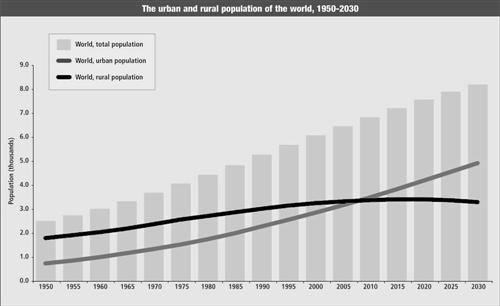
Figure
5: World Rural vs. Urban Population since 1950 (Source: UN Population Division,
2005)
I think that last sentence was
wrong. Can I rephrase it?
World population is growing,
because
urbanization has allowed it to grow so quickly. Modern urban living has provided
humans with a multitude of services on tap, through wires or just down the road,
allowing people to get on with the important business of earning money and
enjoying the fruits of their last shopping trip. It has consequently also
provided what architects refer to as “housing units”, which can be crammed
in left, right, centre, up and down; in tower blocks, terraces and clusters of
identikit housing which keep pushing towns and cities further into the wild.
Space to live? Space to multiply, certainly.
The UN report states: “During
the next few decades the urban areas of the less developed regions are projected
to absorb all the population growth expected worldwide. That is, global
population growth is becoming a largely urban phenomenon.”[xx]
Urbanization is usually defined
in terms of the density of human population, but there is more to it than that.
An urban environment is dominated by humans. The domain of humans is
becoming the city: a complex infrastructure of housing, commercial and public
buildings, utilities and transportation, which has little or no space for those
species that cannot adapt to suit the urban way of life. The fifty percent level
of urbanization is a monumental event; it indicates the point at which global
humanity has become not only culturally, but physically associated with the
dominance of cities. This is what it means to be “civilised”.
With close to 7 billion people on
Earth, the kind of subsistence[xxi]
behaviour that supported just a few people thousands of years ago, and still
supports pockets of humanity in some areas, doesn’t seem possible – there
doesn’t seem to be enough land or wildlife to go round. Surely city dwelling,
with its emphasis on high density, high efficiency living is the only way to
support even the 4.6 billion people that WWF and the Optimum Population Trust
say is sustainable, isn’t it? One way of answering that question is to
consider how much land a person needs to grow their own food and obtain the
other basic requirements for life, such as shelter and clothing.
An interesting analysis was
carried out by Andy Collier in 2007, who estimated[xxii]
that a family of four would need around 0.5 acres (0.2 ha) to be fully self
sufficient as a family unit. For seven billion people, this works out as 3.5
million square kilometres, or 2.4 percent of the Earth’s land surface. Even if
we triple this to allow for building, clothing and heating materials, it is
still a mere seven percent of the entire Earth’s land surface – a tiny
proportion of the land area that humanity is directly affecting at the current
time. However, we do not live off the land, we live largely in a civilized
culture.
It takes a radical thinker like
Derrick Jensen to put that into perspective: “Cities, the defining feature of
civilization, have always relied on taking resources from the surrounding
countryside, meaning, first, that no city has ever been or ever will be
sustainable on its own, and second, that in order to continue their ceaseless
expansion cities must ceaselessly expand the areas they must ceaselessly
hyper-exploit.”[xxiii]
He goes on to explain the psychology behind city living; a state of mind that
allows urban dwellers to lose the connection with the areas that supply them
with resources – much like the increasing number of people who don’t
understand how their food is made, or why it is not necessarily a good thing for
a European or an American to have sacks full of plastic toys for Christmas. The
city dweller – the civilized human – is cut off from his life support
system. The food, clothes, building materials, even the energy, may as well come
from another world.
There is a sad sense of
inevitability to all of this, in that we have probably got where we are simply
because of who we are. We are humans, we have become more numerous than the
Earth can apparently cope with, but there is no turning back because evolution
has taken us somewhere that we feel is the pinnacle of existence. You may well
think that, and I really wouldn’t blame you if you did. Hold that thought.
References
[i] I like the term ‘Survival Machine’. You can read more about this term at http://www.edge.org/documents/ThirdCulture/j-Ch.3.html (accessed 10 October, 2007)
[ii] These opinions are taken from friends, common beliefs and my own thoughts. You might like to add some of your own.
[iii] Or “COmmon aNCESTORS”: Richard Dawkins, “The Ancestor’s Tale”, Houghton Mifflin, 2004.
[iv] Richard Fortey, “Life: An Unauthorised Biography”, HarperCollins, 1997.
[v] ITIS (the Interagency Taxonomic Information System) is a US Government resource, but is available to all Internet users. See http://www.itis.gov/itis_phy.html (accessed 11 October, 2007)
[vi] I am trying to remain consistent with my spelling of words that are different, depending upon the ‘type’ of English being used. Many Americanized spellings – like ‘Americanized’ – are actually derived from the original British spellings. Mid-Atlantic is the best way of describing my approach.
[vii] William F. Bynum, “The Great Chain Of Being After Forty Years: An Appraisal”, History Of Science (13), 1975.
[viii] Edward O. Wilson, “Success And Dominance In Ecosystems: The Case of Social Insects”, 1990, Ecology Institute.
[ix] May R. Berenbaum, “Buzzwords”, Joseph Henry, 2000.
[x] It is true that the archaea bacteria that sit at the very roots of life are anaerobes, i.e. they can live without oxygen, and oxygen is lethal to many of these bacteria (Richard Fortey, “Life”, Flamingo, 1998), but it is also true that the majority of autotrophs do not require such harsh conditions.
[xi] UN Department of Economic and Social Affairs: http://esa.un.org/unpp/ (accessed 15 October, 2007)
[xii] Sources : http://esa.un.org/unpp/ (UN Department of Economic and Social Affairs) and http://www.census.gov/ipc/www/worldhis.html (US Census Bureau) (accessed 15 October, 2007)
[xiii] BCE: Before Common Era. This is a standard convention for historical dating. Equivalent to BC in Christian cultures.
[xiv] CE: Common Era. CE is another standard convention. This is equivalent to AD (Anno Domini).
[xv] Optimum Population Trust, “Ecological footprinting and the Living Planet Report”, http://www.optimumpopulation.org/opt.sustainable.numbers.html (accessed 15 October, 2007). Their figures are based on the WWF report mentioned in the reference, along with widely available demographic data.
[xvi] Jeff Hecht, “Donkey Domestication Began in Africa”, http://www.newscientist.com/article.ns?id=dn6032 (accessed 15 October 2007)
[xvii] Charles More, “Understanding The Industrial Revolution”, Routledge, 2000.
[xviii] UN Population Division, “The World at Six Billion”, http://www.un.org/esa/population/publications/sixbillion/sixbilpart1.pdf (accessed 15 October, 2007)
[xix] Ed. Geoffrey Parker, “The Times Atlas Of World History”, Times Books, 1993.
[xx] UN Population Division, “World Population Prospects: The 2005 Revision”, http://www.un.org/esa/population/publications/WUP2005/2005WUPHighlights_Exec_Sum.pdf (accessed 18 October, 2007).
[xxi] Subsistence is another way of saying “living off the land”. You catch, pick, dig up and fell anything that you need to survive.
[xxii] Andy Collier, “Self Sufficiency”, http://thesietch.org/mysietch/greenspree/2007/07/17/self-sufficiency/ (accessed 18 October, 2007) and personal communication.
[xxiii] Derrick Jensen, “Endgame. Volume 1: The Problem Of Civilization”, Seven Stories Press, 2006.